Near the Nation’s Capital Lies a ‘House of Hope’
An Inside Look at the National Cancer Institute's Cell Therapy Program
Chimeric antigen receptor T-cell therapies have been approved by the FDA for two indications thus far, with a third for multiple myeloma expected sometime next year. James N. Kochenderfer, MD, a physician-scientist in the Surgery Branch of the National Cancer Institute, is one of the few people who can say they have been a part of CAR T-cell development in all three areas that have demonstrated historically high response rates among patients with advanced blood cancers.
Knowing that he has been at the forefront of one of the most significant developments in cancer treatment must provide a satisfying feeling for Kochenderfer, and he agreed it has been a humbling experience.
“It’s been a lot of hard work, but also good luck to get in this field at the right time, and be in the right situation to be able to do this kind of research,” he told Cell Therapy Next.

Source: H. Darr Beiser (all images)
The right time, but also the right place, according to those with whom we spoke. The National Cancer Institute operates as one of the National Institutes of Health, and its physician-researchers see patients at the seemingly endless and massive temple to health care known as the NIH Clinical Center in Bethesda, Maryland. Cell Therapy Next spent the day with researchers and clinicians involved with the NCI’s cellular therapies program and discovered the uniqueness that keeps one of the world’s most experienced cellular therapy providers at the forefront of a field that is now being recognized for its historic contributions to cancer care.
A House of Last Hope
One of the unique aspects of cancer care at NCI and the NIH Clinical Center are the patients themselves, who garnered unanimous mention by the NCI staff .
With its focus on early-stage clinical trials, the NCI sees patients who have failed or experienced relapse after previous therapies and now turn to the Clinical Center as “their last hope,” according to David F. Stroncek, MD, a senior clinician in the department of transfusion medicine at the NIH Clinical Center and director of the Center for Cellular Engineering.
“We are called a House of Hope by some of our patients,” Stroncek told Cell Therapy Next.
“Being that we’re the last hope, once we get the effective protocols in place, there’s a lot of energy in the institution and excitement about getting more patients enrolled to treat because we are extending life for people who for whom treatment has failed with everything else.”
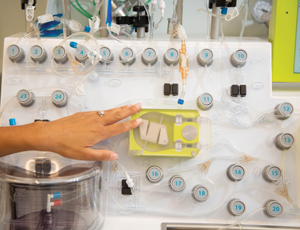
Patients are highly motivated — a characteristic that Stroncek and his colleagues are certain to point out about those seen at the NIH Clinical Center. Patients come from all over the country to receive treatment at the center and it requires a higher level of dedication than would normally be seen in the average patient, he added.
The NCI’s ability to rapidly translate both newly developed cell therapies and patient treatment protocols is another facet to its unique blend of cancer care. Stroncek mentions the contributions of Nirali N. Shah, MD, a Lasker Tenure Track Investigator in the pediatric oncology branch of the NCI, who evaluates and treats children and young adults with acute lymphoblastic leukemia (ALL) who have undergone previous lines of therapy and are now looking for their last, best chance at beating cancer.
“The ability to very rapidly translate, bench to bedside and back, is a unique feature of the NCI,” Shah told Cell Therapy Next. “As a clinical researcher, it is impressive to see how quickly we are translating these novel therapies, and taking them into patients in early-phase clinical trials. I think the ability to rapidly translate really doesn’t exist in many places.”
Shah, who knew she wanted to be involved with pediatric oncology since her first St. Jude Math-a-Thon when she was 10, says that the NCI is the perfect landing spot for someone interested in pediatric cancer care. Because there is often limited investment in early-phase clinical trials for pediatric patients with rare cancers, one of the roles of the NCI from her perspective is to focus on advancing therapies for rare pediatric indications that the commercial pharmaceutical companies may not be able to prioritize.

“In the pediatric oncology branch we’re trying to come up with either new therapies that overcome chemotherapy resistance, immunotherapy resistance, or trying to address an unmet need,” Shah said. “Our goal is to find that opportunity where we can either advance upon currently existing therapies or identify new strategies.”
Shah also takes the opportunity to recognize the uniqueness of patients she sees at the NIH Clinical Center. They often come to her after all other therapies have failed and now their parents are looking to enroll them in early-phase clinical trials, or at least have a conversation about it.
“Of course, you want to be hopeful that these novel CAR T cells are going to work, but you have to sprinkle that hope with a little bit of reality to talk clearly about the expectations, what are the goals of care, and to have the discussions about what happens if this doesn’t work?,” Shah explained.
She says that CAR T-cell therapy has dramatically changed the expectations around what is possible for children with advanced hematologic malignancies.
“It used to be that in early-phase clinical trials, where the primary goals are to determine saftey and toxicity, you were lucky if you had a 20% or 30% complete remission rate. With CAR T-cell therapies, even in the early-phase trials, we are seeing 60%, 70%, or 80% remission rates. It’s really changed the dynamics of what a phase 1 trial could mean in the era of CAR T-cell therapy. We have to be very cautious with our patients, especially as we start exploring CAR T-cell therapies in other diseases such as solid tumors or going beyond B-cell malignancies where the toxicity and efficacy may not be as well established.”
It’s About Science, Not Profits
The freedom to explore new strategies or advance on existing therapies without a commercial profit motivation or the need to constantly apply for research grants are other aspects of working at the NCI that make it unique compared with other research institutions. This lack of a commercial driver also allows clinicians at the NIH Clinical Center to spend as much face time as needed with their patients, all while providing world-class medical care, according to Christian S. Hinrichs, MD, an investigator in the Experimental Transplantation and Immunotherapy Branch at the NCI.

Hinrichs, who specializes in HPV-associated cancers, agrees that patients who come to the NIH Clinical Center are often highly motivated: many times they seek him out and are already looking to participate in early phase T-cell therapies.
“The care here is amazing,” Hinrichs told Cell Therapy Next, adding that his patients really appreciate the time he can spend with them.
“We’re not in a clinic seeing standard-of-care people where we have to have a certain rate of patient turnover every 15-minute office visit to cover overhead or keep our department working,” Hinrichs said.
This lack of financial pressure allows clinicians the time to sit down and unhurriedly explain the treatment process, the underlying biology, and to respond to the patient’s questions.

“From the physician point of view, we’re all getting paid government salary, so there’s not the pressure that we’ve got to be in the clinic and see a lot of patients every day to make a living,” Stroncek said. “It creates a nice collaborative environment, and a lot of really good teaching goes on that ultimately helps with patient care.”
Stroncek confirmed that NIH clinicians can spend as much time as they need with a patient and this liberty extends to collaborating between laboratory research investigators and clinical researchers who perform patient care.
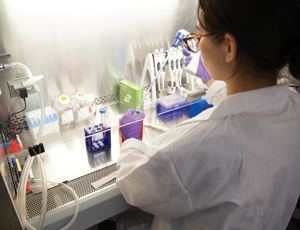
“If something didn’t quite go well with a cell therapy, we can have time to sit down with our colleagues and troubleshoot what went wrong and discuss whether to change anything moving forward,” he said.
Kochenderfer also highlights the bonus of the NCI and NIH Clinical Center being a clinical research facility that deals only with clinical trials. “Every single patient here is a research patient,” he said. This allows [clinicians] to see fewer patients and does require some recruitment of patients from across the country. However, the clinical research setting provided by the NCI and NIH is a bonus to patient care in that it is freely provided to those who are treated at the NIH Clinical Center and the availability of cell-based therapies is enhanced due to their in-house capabilities.

“NIH is very different than university medical centers ... because patients don’t have to pay for any of the treatment, we don’t deal with insurance companies. We have a lot of freedom as far as being able to spend money on the clinical care of patients and the research protocols, which is a huge advantage over universities,” Kochenderfer said.
The NIH’s Center for Cellular Engineering manufactures all of Kochenderfer’s, Shah’s, and Hinrichs’, clinical CAR-T and TCR-engineered T-cell products and it is located in the NIH Clinical Center.
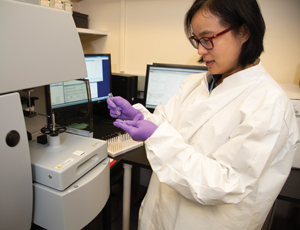
“A huge advantage of the NIH is that the cell products can be produced on-site,” he said. “It takes a huge amount of money to make these cells and being here at the NIH and having this ability to get the cells made here is an incredible advantage.”
Another advantage of working at the NCI is the overall funding mechanism that does not require investigators to “constantly write grants to keep the lab going, so we can have some stability of research funding,” Kochenderfer said.


Echoing Shah’s previous assertion that the NCI allows research to flow from bench to beside and back, Kochenderfer said that you can come up with an idea and test that idea at the NIH faster than almost anywhere else in the world.
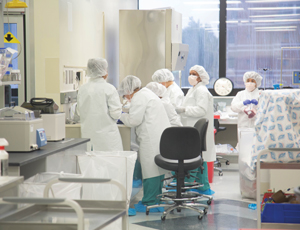
It’s All About the Antigens

The NCI is currently involved in hundreds of clinical trials, many of which are related to immune effector cell therapies. Culling out which are the most promising is a tall order.
“I think our TCR [T-cell receptor] for the HPV-associated epithelial cancers is the most exciting thing,” Hinrichs said when asked.
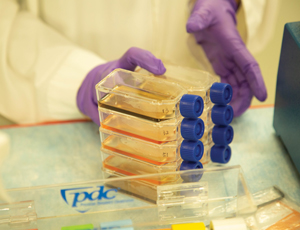
“We’ve seen some really remarkable responses,” he added. “It’s a well-tolerated treatment, and it’s really the first strong sign of success using this sort of an approach in an epithelial cancer or the field.”
Hinrichs said his interest in HPV-associated cancers comes down to the target antigens caused by HPV, which are not human antigens.

“In targeting them, there’s really no risk of targeting healthy tissue,” Hinrichs said. This is unique in the area of solid tumors, he added, because so few antigens are consistently expressed by solid cancers and by a high percentage of the cancer cells.
Epithelial cancers present the most attractive antigen target, he said. “It made sense to start by studying those cancers where there is an attractive target to manage, it’s consistently expressed, and that is a good starting point to build a model, to understand principles that might be more broadly applied.”

Hinrichs said that their potency is what makes T cells an attractive therapy to use against solid tumors. “T cells can be engineered to target a particular antigen and they can do that with extraordinary potency,” he said. “They can potentially kill every antigen ... and they do it so well that they can clear the body of viruses.”
When using T cells to target antigens on the surface of cancer cells, Hinrichs said there’s concern whether they will work in such a way that they do kill every antigen-positive cell, especially those expressed on healthy tissues.
“That ends up being a limiting problem that prevents development of the treatment,” he said. Hinrichs said he must contemplate which antigens can be targeted with impunity and hopes that HPV-associated cancers and epithelial tissues can be solid targets for T-cell receptor therapy.

The search for more cellular therapy targets is an area of new research identified by Shah. Approximately half of patients who received anti-CD19 CAR T-cell therapy will relapse within 1 year because their cancer will evolve and no longer express the surface CD19 antigen.
The most exciting possibilities for Shah lie in the use of dual targeted CAR T-cell therapies for leukemia in patients who relapse after receiving anti-CD19 CAR T-cell therapy. A current trial at NCI is targeting CD19 and CD22 antigens on the surface of cells and is being tested in patients with relapsed acute lymphoblastic leukemia.
“I think everybody wants to have the promise of CAR T-cell therapy,” she said. “Our task, and one of the things that I want to do here in the pediatric oncology branch, is to try to say, ‘Here’s our coverage strategy. What are the limitations and how can we overcome those limitations?’”
Kochenderfer agreed and said that research into targeting more than one antigen is “one of the most important things” going on at NCI now.

He said they are working on targeting two antigens at once for lymphoma and exploring new antigens like SLAMF7 for multiple myeloma.
“I want to develop therapies for multiple myeloma that have these long, 9-year remission rates like lymphoma,” Kochenderfer said.
“We want to be able to basically induce long, multi-year remissions. In most people right now with anti-CD19 CAR-T cells, about 40% of people obtain multi-year remissions. We want to increase that from 40% to a much higher number.

“What we’re most interested in is finding more antigens, and targeting more than antigen at a time,” Kochenderfer, said.
A Look Toward the Future
The NCI is one of the pioneers of cell-based cancer therapies, and much of it was based on the ground breaking work of Steven A. Rosenberg, MD, PhD, chief of the surgery branch and head of the tumor immunology section at the NCI, who continues to investigate the importance of antigen targeting and T-cell based therapies for the treatment of solid tumors. It’s from this view at ground zero of the cell therapy movement that we asked its current crop of investigators what the future of the field may hold.
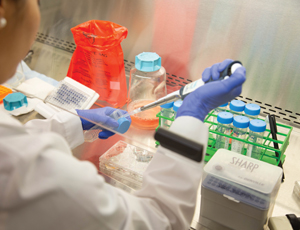
“I don’t know where I’ll be in 10 years, but I can tell you that we’re going to encounter challenges in tumor intrinsic mechanisms of resistance, so understanding those mechanisms so that we can map out strategies to overcome them is the next step,” Hinrichs said. “The step after that is going to be discovering technologies to overcome those limitations.”

Hinrichs added that further into the future, another challenge will be identifying more antigens that they can target with engineered cell-based therapies.
“We’ve had tremendous success in targeting B-cell malignancies, and I think that we need to see those same successes happen in other types of diseases,” Shah said. Another trial of interest at NCI will start enrolling patients with acute myeloid leukemia by the end of this year and will explore treatment with CAR-T cells that target CD33. It’s a patient population with poor outcomes, Shah said.
She described CAR T-cell therapy as a “truly tremendous breakthrough.” Current CAR T-cell therapies for B-cell malignancies treat patients who have exhausted all of their therapeutic options, “and finding a strategy where, if you can manufacture a CAR T-cell product, you’re getting 80% to 90% complete remission rates, was previously virtually is unheard of,” Shah said.

“That is in a very select group of patients, in a select group of diseases, and we really need to try and see what we can do to optimize this therapy, and this paradigm, in other settings,” she added. “We know what the potential of a CAR T-cell therapy holds, so we need to see if we can take it into other areas, be it lymphomas, solid tumors, or other types of cancers.”
Stroncek says the field of cell therapy is an incredibly fast moving one, and he believes that CAR-T cells and engineered T-cell receptors will have an impact on treating more diseases in the future.
“If a cancer center is going to be at the forefront of treating leukemia or lymphoma, then they must be able to do chemotherapy or radiation therapy, bone marrow transplant, and cell therapy,” Stroncek said. “I think in the future there will certainly be more effective cell therapies, and if a cancer center wants to specialize in any kind of cancer then it will have to offer all these services and be able to provide cell therapies to patients.” – by Drew Amorosi
- For more information:
- Christian S. Hinrichs, MD, can be reached at Center for Cancer Research, National Cancer Institute, Building 10, Room 4B04, Bethesda, MD 20892; email: hinrichs@mail.nih.gov.
- James N. Kochenderfer, MD, can be reached at Center for Cancer Research, National Cancer Institute, Building 10-CRC, Room 3-3888, Bethesda, MD 20892; email: kochendj@mail.nih.gov.
- Nirali N. Shah, MD, can be reached at Center for Cancer Research, National Cancer Institute, Building 10-CRC, Room 1-5752, Bethesda, MD 20814-1826; email: nirali.shah@nih.gov.
- David F. Stroncek, MD, can be reached at NIH Clinical Center, Building 10, Room 1C711, 10 Center Dr., Bethesda, MD 20892; email: dstroncek@mail.cc.nih.gov.
Disclosures: Hinrichs, Kochenderfer, Shah, and Stroncek have no relevant financial disclosures.










